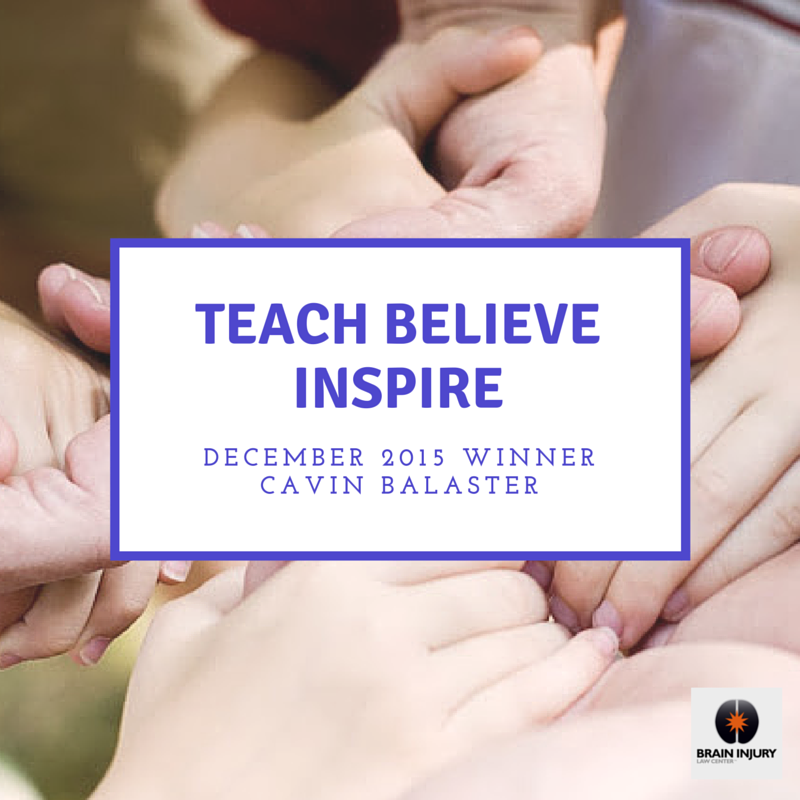 There are a lot of words and phrases that can describe the experience of undergoing a traumatic brain injury (TBI). Over the years of interviewing TBI survivors for this blog and working with many, many more on their litigation cases, we thought we had heard them all.
There are a lot of words and phrases that can describe the experience of undergoing a traumatic brain injury (TBI). Over the years of interviewing TBI survivors for this blog and working with many, many more on their litigation cases, we thought we had heard them all.
But after encountering Cavin Balaster, we heard a new description of TBI. One that challenges perceptions of what TBI really means, and encourages everyone to rethink their presumptions of what is possible for survivors. For his clever, courageous reassessment of the nature of TBI, we are pleased to present Cavin Balaster as our Teach Believe Inspire award winner for this month.
“Riding High in April, Shot Down in May”
Frank Sinatra’s song “That’s Life” has always been relevant to Cavin. The lyrics “riding high in April, shot down in May” have echoed in his memory ever since a life-changing night in May.
Brooklyn, New York was at a cultural apex in 2011, an enclave of independent creatives who had disproved the “starving artist” cliche. Success as an artist was synonymous with living, working, collaborating and (of course) partying in Brooklyn. And that’s just what Cavin Balaster was doing on a beautiful night in May.
With a bunch of fellow musicians, he was headed up to a soirée on an industrial building rooftop, held in the shadow of one of Brooklyn’s iconic water towers. They were a little drunk when they arrived, but mostly buzzed on the excitement of the glamorous setting and the feeling that they were winning at life. It made Cavin more than a little reckless—he climbed the rickety ladder up the side of the water tower, hoping to get a better view of the Manhattan skyline. His brain has lost all recollection of what happened next.
He fell. His head struck the steel scaffolding on his way down. He hit his head again on the concrete rooftop floor where his friends stood back in horror.
All told, it was a 20-foot fall, about the height of two stories.
At the hospital, doctors determined that Cavin had bruised the left frontal cortex of his brain when hitting it against the scaffolding. He’d also sustained a subdural hematoma (blood pooling within the brain’s outermost layer) and shearing in the corpus callosum.
This last injury, alternately known as diffuse axonal injury, was the most serious of all. It happens when the brain moves back and forth, hitting the sides of the skull. His chances of recovery were put at less than ten percent.
But after twelve days in a coma, Cavin woke up. He had multiple fractures, a lacerated kidney, and a bruised and swollen left eye. He’d developed pneumonia and MRSA from the doctors’ attempts to suction fluid from his lungs. He had memory loss, double vision, and speech and motor impairment. The one thing he didn’t have was medical insurance.
Not the most auspicious start to an adventure.

“The Connections I Needed to Make”
The slim margin of people who do wake up from a diffuse axonal injury usually spend their lives in a vegetative state. By some miracle, Cavin had retained his cognitive function enough to begin working toward recovery. Although his brain’s interpretation of his vision was damaged, through the support of family and friends, he was able to get the medical care he needed, which meant spending a long time in a wheelchair.
With the ability to play music again still a long way off in his recovery journey, Cavin began to write about his experience as soon as his fingers could negotiate a computer keyboard. This is where the tragedy began to morph into an adventure.
“I felt compelled to write,” he says, “…to construct a grounding narrative in order to integrate the trauma that my body registered but my damaged mind had not been able to yet grasp. Blogging was so beneficial because it forced me to take the ‘right brain trauma’ that I experienced, and to bring it to a ‘left brain narrative.’ This activity was precisely the connections that I needed to make around the damaged areas.”
Through his artistic sensibility and determined grit, Cavin was able to process each day’s grueling efforts into an ongoing story that helped him understand himself—body, mind and spirit—in a brand new way.
[socialObu shorturl=”http://ow.ly/WhF89″ ]We are pleased to present Cavin Balaster as our Teach Believe Inspire award winner for this month.[/socialObu]
A Story That Others Can See Themselves In
As the blog’s entry count climbed to over 60,000 words, it gathered more and more followers around the world. Other TBI survivors, along with their families and friends, saw themselves in Cavin’s story and were inspired to see themselves differently, as well. By the time Cavin decided to create a book from his blog, the world was primed to receive it. His Kickstarter campaign to fund the book went viral. At the end of his fundraising drive, the book had received 120% of its funding goal. (The book—Lights, Coma, Action!—is due out in 2017.)
In the meantime, Cavin’s physical recovery had progressed remarkably, but his eyesight still suffered from the effects of the fall. He continued to suffer from diplopia, or double vision, brought on by damage to the fourth cranial nerve in his brain. As Cavin describes, “The communication between my brain and one of the ocular muscles is partially paralyzed.”
In order to get better care for this condition, Cavin moved to Austin, Texas to undergo therapy at the Austin Center for Vision Development. Not only has his vision immensely improved there, but it gave him new opportunities to reengage with his love of music. In March 2013, Cavin played his first post-TBI show at Austin’s famed SXSW festival.

“Mr. Bounce”
These days, Cavin is studying physiology, biochemistry and neuroscience, as well as many forms of alternative therapy, with the goal of opening his own brain injury clinic one day. His optimistic outlook and impassioned charisma have made him a sought-after speaker on many topics related to brain health. His particular emphasis is on nutrition for brain building—“food for thought,” as he calls it. He also appears on many podcasts, blogs and other media with the goal of creating affordable resources for families like his own who were, not that long ago, desperate for guidance and support.
“As I got better, my friends began to call me ‘Mr. Bounce’ …because I seemed to ‘bounce right back!’ I did not bounce though… It is a haul, not a bounce. There is no undoing a brain injury. No two brains are the same, so no two brain injuries are the same. But an exact diagnosis is not necessary to help brain injury survivors now! Even without the ability to accurately diagnose a brain disorder, if we can support the environment that the neurons are in (glia), then the neurons can thrive.”
We congratulate Cavin for using his recovery to offer help and hope to the TBI community and turning his story into an adventure that can inspire others.


